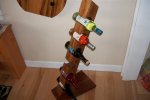Stuart Ablett
Member
- Messages
- 15,917
- Location
- Tokyo Japan
Take your board, drill a pilot hole (use the same size of drill that your hole-saw uses for a pilot hole, or even one size smaller than the hole-saw for each large hole in the spot you want it, mark the board so you know the orientation, then rip your board on a bandsaw into three or four pieces, then using your hole-saw and the pilot holes you have drilled cut out the larger holes. Get the orientation of the boards right, glue the whole thing up and no one will know you ever ripped the board down to start.




